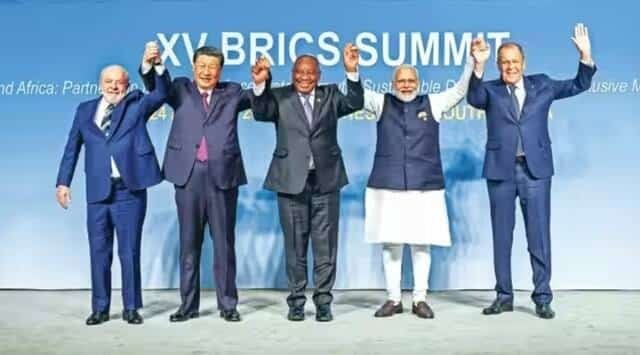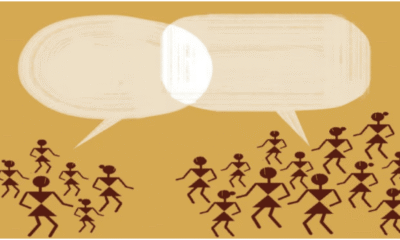
|
Getting your Trinity Audio player ready...
|
(The article was originally published in Indian Express on August 26, 2023 as a part of Dr Madhav’s column titled ‘Ram Rajya’. Views expressed are personal.)
China is the world’s second most powerful nation. Yet, President Xi Jinping insisted at the BRICS summit in Johannesburg that it would be a part of the “developing world”. Although India aspires for the tag of a “developed country” by 2047, Prime Minister Narendra Modi emphasises on the construct of “Global South”, and describes BRICS as a platform “for discussing and deliberating on issues of concern for the entire Global South”.
As the so-called developed countries struggle to manage their economies, putting a question mark over their future trajectory, this new discourse of Global South acquires significance.
It leads to an interesting question: What is a developed nation? The World Trade Organisation says that it doesn’t have any definitions for “developed” and “developing” countries. “Members announce for themselves whether they are ‘developed’ or ‘developing’ countries. However, other members can challenge the decision”, it says.
The United Nations, too, does not have any clear definition. Yet, it categorised entire Europe, North America, Japan, Australia and New Zealand as the “developed world”, and the remaining 150 plus countries as “developing”.
Many have been questioning this classification. In 2014, in their “annual letter”, Bill and Melinda Gates argued that “the terms ‘developing countries’ and ‘developed countries’ have outlived their usefulness”. Bill went on to claim that by 2035, “there will be almost no poor countries left in the world”.
He may be right. Many poor countries in Africa rose to become self-sufficient in several areas over decades. There was a time when Turkey used to be described as the “sick man of Europe”. Although some may argue that the country is receding to that status under Erdogan once again, with a per capita GDP of over $12,000, and an impressive HDI performance, it is better off than many of its neighbours today.
On the other hand, Germany’s economy is facing one of its worst phases, prompting some analysts to call Europe’s best performing nation the new “sick man of Europe”. The IMF projects that the country would be the only developed economy in Europe to shrink this year. High inflation rates, growing unemployment and emptied-out order books for industrial production are haunting the German economy.
This classification makes no sense for another reason. The so-called developing world has countries like Mexico with per capita GDP of above $10,000, and also Burundi, Sierra Leone and Malavi with a per capita GDP of less than $500.
Going by the general definition, a developed country should have a developed economy with reasonably high GDP, advanced physical, scientific and technological infrastructure, and good quality living standards called HDI.
Countries like India and China are competing with some of their “developed” counterparts on some of these parameters. Latvia with a total GDP of $30 billion is called a “developed” country because its 2 million-strong population takes its per capita GDP to $34,000, whereas India with more than 125 times bigger GDP of $3.75 trillion would still be considered a “developing” country because its whopping population of 1.4 billion brings down per capita GDP to just about $2,700.
India’s performance on several development indices has been exemplary in the last one decade, placing it on par with many developed countries. Investment company Morgan Stanley predicts that the transformational changes set in motion by the Modi government are set to “propel the country to doubling per capita income, doubling export market share, boosting corporate profits, and significantly improving other economic health indicators”.
In a recent report titled “How India has transformed in less than a decade”, it highlighted 10 major changes in the Indian economy, like supply-side reforms, RERA Act, ISB code, and DBT, that had far-reaching consequences. It predicted that riding on the positive impact of these reforms, the Indian economy is set to reach the $8 trillion mark by 2031 and register a GDP per capita of over $5,200.
India’s infrastructure growth in the last nine years has been phenomenal. Twenty cities in India today boast of metro rail projects. Seventy-four new airports have been built or operationalised in the last nine years. One hundred and eleven waterways have been declared as “National Waterways”. Indian railways is scripting history with the introduction of 15 indigenously built Vande Bharat trains and another 400 in the pipeline in the next three years. Port infrastructure and highways also saw significant improvement.
The latest successful soft-landing of Chandrayaan-3 on the Moon’s surface catapulted India into the “club of four” that conquered the Moon. From space to digital to oceans, India’s technological advancements are a wow factor for many developed countries too.
It is in this context that the Indian leadership’s use of the phrase “Global South” should be appreciated. Many interpret it as a new term for the developing world. Some dismiss it as a product of the developing world’s inferiority complex and suggest that “New North” would be a more appropriate description. However, as the dividing lines between “developed” and “developing” nations are fast blurring, it will be a mistake to interpret Global South on the same indicators. What distinguishes Global South from its counterparts in Global North is more cultural issues than economic or developmental ones.
As new agenda items like sustainable living, ecological balance and universal healthcare take precedence in global discourse, a need for changes in lifestyles and attitudes is being acutely felt everywhere. One scholar pointed out that the real division between the North and the South should be on the lines of “fat” and “lean”. While over-consumption and crises associated with it became the hallmark of Global North, an eco-friendly worldview of the countries in Global South, from Latin America to Africa to Asia, stands out as a beacon for a new global culture.
Reemphasising the “developing” versus “developed” discourse may serve Xi’s and China’s political expediency. But Modi’s “Global South” focus would be for reforming the world by carrying the light of wisdom from it to the rest of mankind.




